Euphorbia tirucalli
Euphorbia tirucalli L.
Family: Euphorbiaceae
Common names: pencil plant, rubber-hedge euphorbia (Eng.); kraalmelkbos (Afr.)
SA Tree No: 355
Introduction
Euphorbia tirucalli has unmistakable, brush-like branch masses that are a noticeable feature of the plant. It occurs over the widest distribution of all local euphorbias and is also a very variable plant, ranging from many-branched shrubs to large trees, depending on the particular habitat.
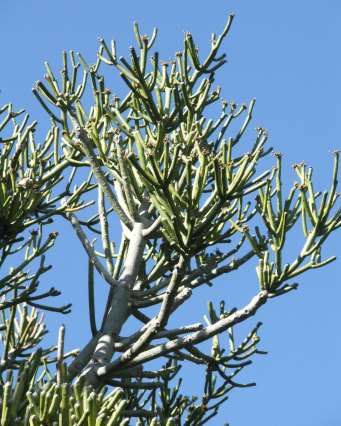
Description
Description
The rubber-hedge euphorbia is a many-branched, succulent plant, usually 3-5 m but may reach 10 m on occasion. The bark of very old specimens is grey and rough with longitudinal dents and ridges that break up into very small fragments. There are sometimes conspicuous, small protuberances, such as bulges, knobs, or swellings, on the bark, and occasionally black, rough, crosswise bands. The branches are cylindrical, smooth and glabrous-green, 5-8 mm in diameter, forming brush-like masses that are the best-known feature of this species. The plants do not have spines.
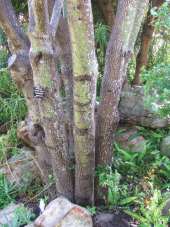
The leaves are small and slender, up to 12 x 1.5 mm, and are rarely seen as they fall very early. Leaf scars on young twigs form conspicuous dents which contract until they are no more than grey dots on older branchlets; they can even be seen on fairly thick green stems. The thin twigs are pendant (hanging down), pale green, and occur opposite each other, alternately, or in groups on the branchlets, which gives a rather untidy and rounded appearance to the crowns.
The flowers are yellow, inconspicuous, and carried in clusters at the apex of the short branches or in the angles of branches. They appear from September to December.
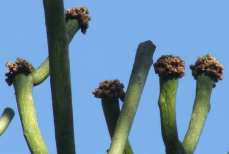
Fruits are tripartite capsules (divided into three parts), about 12 mm in diameter, longitudinally very slightly lobed, short-stalked (8 mm), pale green, with a pink tinge and conspicuously pubescent (clothed with soft hairs). As with other members, the capsules dehisce while still on the tree. The fruits appear from November to December. The stalks are generally bent at an angle.
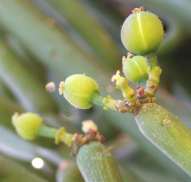
The seeds are oval, about 4 x 3 mm, glabrous, smooth and dark brown with a white line around the small white caruncle (fleshy wart near the hilum of the seed). This spineless species contains large quantities of latex which is freely exuded by the twigs and branchlets at the slightest injury.
Conservation Status
Status
Euphorbia tirucalli is abundant in southern Africa and seeds itself freely across its distribution range. It is well represented in various habitats and is not an endangered species.
Distribution and habitat
Distribution description
There are more than 2000 species of Euphorbia found in the warmer parts of the world. Of approximately 200 species found in South Africa, 14 can be seen as trees. These succulent trees resemble cactus plants and at first glance are often mistaken for cacti.
The rubber-hedge euphorbia has its southernmost African distribution in the Eastern Cape and its northernmost in Ethiopia. It is therefore present in all the warmer parts of South Africa, and is particularly abundant in KwaZulu-Natal, where sometimes pure stands can be observed. Outside Africa it also occurs in India, Indonesia, China and the Philippine Islands.
Euphorbia tirucalli occurs in various habitats ranging from grassy hills, rocky outcrops and ridges, along river courses, bushveld and open savanna. The associated geology varies between granite, sandstone and rhyolite. Dense thickets are associated with this species, and the plant itself may form hedge-like barriers in the veld.
Derivation of name and historical aspects
History
The family name Euphorbiaceae and genus name Euphorbia were named in honour of a Linnaean hero namely Euphorbus, 1st century physician to King Juba of Mauritania. He is believed to have used plants of this genus as medicine. The species name tirucalli was given by Linnaeus in 1753 as this was the name used by the natives of Malabar, a region of southern India. The rubber-hedge has been so widely cultivated that it is now difficult to say where it occurs naturally and where it has been introduced. Early traders and sailors carried plants from South Africa to India and the Far East, and the fact that these have all flourished gives us some idea of the incredible resilience of the plant.
Ecology
Ecology
Euphorbia tirucalli produces yellowish flowers that attract butterflies, bees and other insects. These are primarily responsible for pollination as the flowers also produces minute quantities of nectar. The seeds are also eaten by various birds. The plant itself has very bushy branches which are used for nesting and roosting, and the spineless branches are an added advantage to the birds.
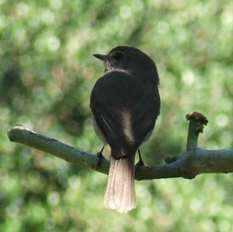
The pencil plant is drought-resistant and very resilient, which is why it has become popular in cultivation. It uses its green stems to photosynthesise and is therefore able to minimise surface exposure and water loss. As far as can be established, there have been no recordings of animals that eat the branches of E. tirucalli. It is possible that the poisonous latex that the plant produces may act as a deterrent to browsers.
Uses
Use
The common name rubber-hedge euphorbia refers to its widespread use as planted hedges around smallholdings, habitations and livestock pens, which help to keep intruders out. The latex, as in other euphorbias, is very toxic and may cause blindness, blisters on the skin, and even prove fatal if enough of it is swallowed. There is at least one recorded case of it causing death from gastro-intestinal haemorrhage. In traditional medicine it is regarded as a cure for sexual impotence and an antidote for snakebite. The use of various euphorbias including E. tirucalli as a fish poison is also well documented.
Rubber-hedge euphorbia was once thought to be a species that could yield true rubber, but numerous experiments have shown that the latex contains too high a percentage of resin. The plant as a whole contains 0.4% rubber and 5.1% latex. Products manufactured from the rubber were of a low quality. Efforts to use the resin in the manufacture of varnish were also doomed to failure as the product was not durable. The timber of E. tirucalli is white and harder than most related species but it is not put to use in South Africa. As it is not attacked by borers, it is used elsewhere as struts for roofs.
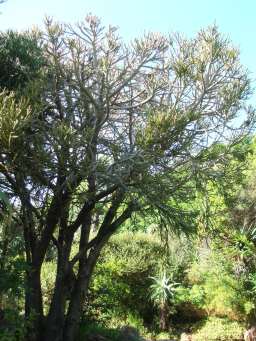
Growing Euphorbia tirucalli
Grow
Euphorbia tirucalli grows moderately fast and thrives in moderate to warm climates. It does not seem to cope with extreme cold. Plants can easily be cultivated by means of seeds, cuttings or truncheons. A coarse sandy medium is ideal for sowing the seeds.
Fresh seeds must be sown in late summer from February to March and kept in a warm, moist area. Plants prefer to have their 'feet' dry, especially in winter. Young plants grow relatively fast and will benefit from a liquid fertiliser and well-composted, well-drained soil. These beautiful trees are best positioned in open, full-sun positions on rocky sites such as rock gardens, embankments or gravelly slopes. They make very good specimens in dry karoo gardens provided that the winters aren't too cold. Other euphorbias that best complement E. tirucalli include E. ingens, E. cooperi, E. triangularis, E. grandicornis, E. tetragona and E. grandidens. For the best garden display, it is advisable to cultivate a combination of large, medium and small succulent plants such as Aloe, Crassula, Cotyledon, Tylecodon and Cyphostemma, while using colourful annuals and perennials in amongst the permanent specimens.
References
- Coates Palgrave, K. 2002. Trees of southern Africa. Struik, Cape Town.
- Germishuizen, G. & Meyer, N.L. (eds). 2003. Plants of southern Africa : an annotated checklist. Strelitzia 14. National Botanical Institute, Pretoria.
- Jackson, W.P.U. 1990. Origins and meanings of South African plant genera. University of Cape Town Ecolab.
- Leistner, O.A. 2005. Seed plants of southern tropical Africa : families and genera. Southern African Botanical Diversity Network Report No. 26. SABONET, Pretoria.
- Smith, C.A. 1966. Common names of South African plants. Memoirs of the Botanical Survey of South Africa No. 35.
- Stearn, W.T. 2003. Stearn's dictionary of plant names for the gardener. Cassel, UK.
- Van Wyk, B-E. & Gericke, N. 2000. People's plants. A guide to useful plants of southern Africa. Briza Publications, Pretoria.
- Van Wyk, P. 1974. Trees of the Kruger National Park, vol. 2. Purnell, Johannesburg.
Credits
Werner Voigt
Harold Porter NBG
December 2007
Plant Attributes:
Plant Type: Shrub, Tree
SA Distribution: Eastern Cape, Gauteng, KwaZulu-Natal, Limpopo, Mpumalanga
Soil type: Loam
Flowering season: Spring
PH: Acid
Flower colour: Yellow
Aspect: Full Sun, Morning Sun (Semi Shade), Afternoon Sun (Semi Shade)
Gardening skill: Easy
Special Features:
Horticultural zones











Rate this article
Article well written and informative
Rate this plant
Is this an interesting plant?
Login to add your Comment
Back to topNot registered yet? Click here to register.